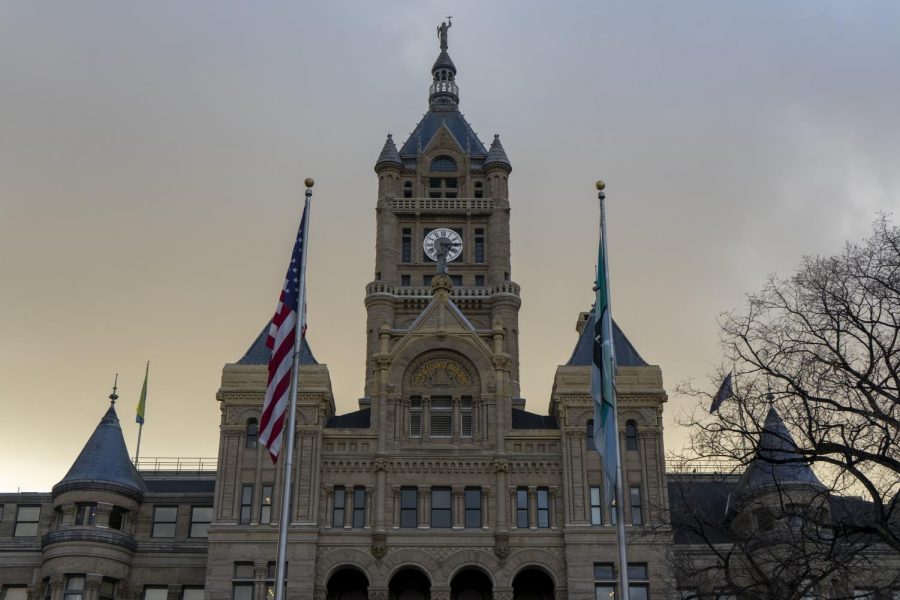Reese: It’s Time for Salt Lake City to Pedestrianize Its Streets
The Salt Lake City and County Building located in downtown Salt Lake City. (Photo by Jalen Pace | Daily Utah Chronicle)
September 10, 2020
The start of the COVID-19 pandemic gave many Americans cabin fever as we stayed indoors to prevent and limit the spread of a deadly virus (which, for the record, is still raging despite Utah leaders’ decision to prioritize the economy over our health). Cut off from friends and family, we spent our nights and weekends binging shows like Tiger King or The Midnight Gospel to pass the monotonous hours at home. Some of us struggled with mental health, something many Utahns are familiar with. In response, many cities closed streets during lockdowns to help residents get outside while maintaining social distance. Salt Lake City was one of those cities.
I was one of the Salt Lakers who benefitted from having a closed street in their neighborhood during the peak of the COVID-19 shutdown. Every night, especially when the sun was out longer, I would walk the street listening to music while keeping my distance from neighbors and enjoying the fresh air. It greatly improved my mental health and helped me feel less isolated from the world.
Now the temporarily closed streets have opened back up, with city data showing that 66% of Salt Lake City residents surveyed were supportive of or neutral to the road closures and the reasoning behind them. Other cities that closed streets, like Seattle, have now moved to permanently pedestrianize certain streets, and bigger cities like New York have more residents pushing to close streets as well. Salt Lake City should redesign its streets around residents rather than vehicles to create a healthier and greener city. While this will take some adjustment, we will be better off as a community once we make this change.
The leading cause of death in Utah is heart disease. Closing down streets to make them more walkable helps combat this. In fact, residents of neighborhoods with low walkability were 33% more likely to develop cardiovascular health issues than those in more walkable areas. Being able to walk outside can also help improve mental health, which is particularly important in a state with such a high suicide rate. Though obviously not a cure-all, greater access to fresh air and exercise can help treat the depression and anxiety many Utahns face in daily life. When streets are pedestrianized, local residents can integrate more physical activity into their daily routines, which is one of the simplest ways to stay active in an increasingly sedentary world.
Higher walkability also leads to increased use of green spaces like parks. Simply by closing roads and turning them to pedestrian use only, cities can encourage people to use parks and other urban green spaces more frequently. And, when deadly viruses aren’t forcing us to limit in-person interaction, studies show that walkability communities create more social communities. Designing our neighborhoods around the people who live there instead of their cars promotes stronger, happier and more united communities, and offers people a better sense of belonging.
Cities all over the world are redesigning their streets to improve local quality of life. Take Barcelona for example, where planners are creating vehicle-free “superblocks” to make the city more walkable. In the United States, up to 80% of livable land is paved over for roads in some cities, and Salt Lake is no different. Our city planners are taking advantage of this unprecedented time as we innovate and reimagine life in a post-pandemic world. Salt Lake City planners can plan and create a more walkable city by closing down unnecessary roads to pedestrianize them. Local advocacy groups like Sweet Streets Salt Lake City are even advocating for our communities to go further by creating an 8-mile section of closed roads to be used by pedestrians and bikers, connecting Salt Lake City, South Salt Lake, Millcreek and Murray. Their work is challenging us to create a more livable Salt Lake County.
The last few decades, not to mention the COVID-19 pandemic, have changed how people live, communicate and commute. Can you imagine explaining half of everything that has occurred in 2020 to yourself ten years ago? The world is constantly changing and growing, for better or worse. Our cities and communities need to do the same without leaving the people who live there behind. Pedestrianizing streets around Salt Lake City would help lead to stronger communities, healthier residents and healthier green spaces. A city can only be as happy and unified as its residents, and as the city that represents our state often on national and international levels, we need to be a livable and vibrant place.








